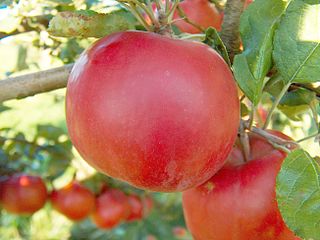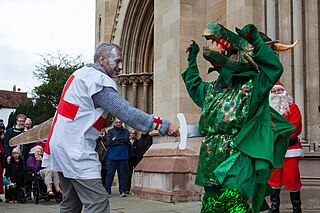Related Research Articles

Halloween or Hallowe'en is a celebration observed in many countries on 31 October, the eve of the Western Christian feast of All Saints' Day. It begins the observance of Allhallowtide, the time in the liturgical year dedicated to remembering the dead, including saints (hallows), martyrs, and all the faithful departed.

Imbolc or Imbolg, also called Saint Brigid's Day, is a Gaelic traditional festival. It marks the beginning of spring, and for Christians, it is the feast day of Saint Brigid, Ireland's patroness saint. It is held on 1 February, which is about halfway between the winter solstice and the spring equinox. Historically, its traditions were widely observed throughout Ireland, Scotland and the Isle of Man. Imbolc is one of the four Gaelic seasonal festivals, along with: Bealtaine, Lughnasadh and Samhain.

Samhain is a Gaelic festival on 1 November marking the end of the harvest season and beginning of winter or "darker half" of the year. Celebrations begin on the evening of 31 October, since the Celtic day began and ended at sunset. This is about halfway between the autumnal equinox and winter solstice. It is one of the four Gaelic seasonal festivals along with Imbolc, Beltaine and Lughnasa. Historically it was widely observed throughout Ireland, Scotland, Galicia and the Isle of Man. A similar festival was held by the Brittonic Celtic people, called Calan Gaeaf in Wales, Kalan Gwav in Cornwall and Kalan Goañv in Brittany.

The Yule log, Yule clog, or Christmas block is a specially selected log burnt on a hearth as a winter tradition in regions of Europe, and subsequently North America. The origin of the folk custom is unclear. Like other traditions associated with Yule, the custom may ultimately derive from Proto-Indo-European religion as similar traditions have been recorded in Celtic, Germanic, Baltic and Slavic paganism, among others.

Michaelmas is a Christian festival observed in some Western liturgical calendars on 29 September, and on 8 November in the Eastern tradition. Michaelmas has been one of the four quarter days of the English and Irish financial, judicial, and academic year.

Halloween costumes are costumes worn on Halloween, a festival which falls on October 31. An early reference to wearing costumes at Halloween comes from Scotland in 1585, but they may pre-date this. There are many references to the custom during the 18th and 19th centuries in the Celtic countries of Scotland, Ireland, Mann and Wales. It has been suggested that the custom comes from the Celtic festivals of Samhain and Calan Gaeaf, or from the practise of "souling" during the Christian observance of Allhallowtide. The Christian tradition of acknowledging the danse macabre is also suggested as the origin of dressing up on Halloween Dressing up is not strictly restricted to Halloween among Christians, with similar practices being observed on holidays like Christmas. Halloween costumes are traditionally based on frightening supernatural or folkloric beings. However, by the 1930s costumes based on characters in mass media such as film, literature, and radio were popular. Halloween costumes have tended to be worn mainly by young people, but since the mid-20th century they have been increasingly worn by adults also.
Midsummer is a celebration of the season of summer usually held at a date around the summer solstice. It has pagan pre-Christian roots in Europe.

A pixie is a mythical creature of British folklore. Pixies are considered to be particularly concentrated in the high moorland areas around Devon and Cornwall, suggesting some Celtic origin for the belief and name.

The most famous Furry Dance takes place in Helston, Cornwall, United Kingdom. It is one of the oldest British customs still practised today. The earliest mention seems to be in a letter to the Gentleman's Magazine for 1790 where the writer says "At Helstone, a genteel and populus borough town in Cornwall, it is customary to dedicate the 8th May to revelry. It is called Furry Day". The dance is very well attended every year and people travel from all over the world to see it: Helston Town Band play all the music for the dances.

Restoration Day, more commonly known as Oak Apple Day or Royal Oak Day, was an English, Welsh and Irish public holiday, observed annually on 29 May, to commemorate the restoration of the Stuart monarchy in May 1660. In some parts of England the day is still celebrated. It has also been known as Shick Shack Day, or Oak and Nettle Day.

Saint John's Eve, starting at sunset on 23 June, is the eve of celebration before the Feast Day of Saint John the Baptist. The Gospel of Luke states that John was born six months before Jesus; therefore, the feast of John the Baptist was fixed on 24 June, six months before Christmas according to the old Roman calculation. This feast day is one of the very few saints' days which commemorates the anniversary of the birth, rather than the death, of the saint being honored.

Golowan is the Cornish language word for the Midsummer celebrations in Cornwall, UK; widespread prior to the late 19th century and most popular in the Penwith area and in particular Penzance and Newlyn. The celebrations were centred on the lighting of bonfires and fireworks and the performance of associated rituals. The midsummer bonfire ceremonies were revived at St Ives in 1929 by the Old Cornwall Society and since then spread to other societies across Cornwall, as far as Kit Hill near Callington. Since 1991 the Golowan festival in Penzance has revived many of these ancient customs and has grown to become a major arts and culture festival; its central event 'Mazey Day' now attracts tens of thousands of people to the Penzance area in late June.

Allantide, also known as Saint Allan's Day or the Feast of Saint Allan, is a Cornish festival that was traditionally celebrated on the night of 31 October, as well as the following day time, and known elsewhere as Allhallowtide. The festival in Cornwall is the liturgical feast day of St Allan, who was the bishop of Quimper in the sixth century. As such, Allantide is also known as Allan Night and Allan Day. The origins of the name Allantide also probably stem from the same sources as Hollantide and Hallowe'en itself.

Saint Martin's Day or Martinmas, sometimes historically called Old Halloween or Old Hallowmas Eve, is the feast day of Saint Martin of Tours and is celebrated in the liturgical year on 11 November. In the Middle Ages and early modern period, it was an important festival in many parts of Europe, particularly Germanic-speaking regions. In these regions, it marked the end of the harvest season and beginning of winter. and the "winter revelling season". Traditions include feasting on 'Martinmas goose' or 'Martinmas beef', drinking the first wine of the season, and mumming. In some German and Dutch-speaking towns, there are processions of children with lanterns (Laternelaufen), sometimes led by a horseman representing St Martin. The saint was also said to bestow gifts on children. In the Rhineland, it is also marked by lighting bonfires.
Nickanan Night is a Cornish feast, traditionally held during Shrovetide, specifically on the Monday before Lent.

A soul cake, also known as a soulmass-cake, is a small round cake which is traditionally made for Halloween, All Saints' Day and All Souls' Day to commemorate the dead in many Christian traditions. The cakes, often simply referred to as souls, are given out to soulers who go from door to door during the days of Allhallowtide singing and saying prayers "for the souls of the givers and their friends", especially the souls of deceased relatives, thought to be in Purgatory. The practice in England dates to the medieval period, and was continued there until the 1930s. In Sheffield and Cheshire, the custom has continued into modern times. In Lancashire and in the North-east of England soul cakes were known as Harcakes, a kind of thin parkin.

The term "hobby horse" is used, principally by folklorists, to refer to the costumed characters that feature in some traditional seasonal customs, processions and similar observances around the world. They are particularly associated with May Day celebrations, mummers' plays and the Morris dance in England.
Canadian folklore is the traditional material that Canadians pass down from generation to generation, either as oral literature or "by custom or practice". It includes songs, legends, jokes, rhymes, proverbs, weather lore, superstitions, and practices such as traditional food-making and craft-making. The largest bodies of folklore in Canada belong to the aboriginal and French-Canadian cultures. English-Canadian folklore and the folklore of recent immigrant groups have added to the country's folk.
The phrase English festivals cover a number of festivals which are Christian and secular that are traditionally celebrated in England. Most festivals are observed throughout England but some, such as Oak Apple Day, Souling, Rushbearing, Bawming the Thorn, and Hocktide are local to certain regions.

Mummers' plays are folk plays performed by troupes of amateur actors, traditionally all male, known as mummers or guisers. Historically, mummers' plays consisted of informal groups of costumed community members that visited from house to house on various holidays. Today the term refers especially to a play in which a number of characters are called on stage, two of whom engage in a combat, the loser being revived by a doctor character. This play is sometimes found associated with a sword dance though both also exist in Britain independently.
References
- 1 2 Hall, S. C., Mr and Mrs (1841). Ireland, Its Scenery, Character &c (PDF). p. 25.
Another old custom prevails also to some extent. May eve, the last day April, is called "Nettlemas night;" boys parade the streets with large bunches of nettls, stinging their playmates [..] These are the only customs peculiar to Cork
{{cite book}}: CS1 maint: multiple names: authors list (link) - ↑ Mooney, James (1889). "The Holiday Customs of Ireland". p. 393.
- ↑ Mac Coitir, Niall (2017). Ireland's Wild Plants – Myths, Legends & Folklore. Gill & Macmillan.
In southern parts of County Cork, May Eve (30 April) was known as "Nettlemeas Night" when boys would parade the streets with large bunches of nettles, stinging their playmates [..] Similar customs were found in Devon and Cornwall, where May 1 (or 2) was known as "Stinging Nettle Day"
- ↑ Sutherland, Eleanor (June 2020). "The Folklore of Nettles" (PDF). wicklowmountainsnationalpark.ie. Wicklow Mountains National Park. Retrieved 17 July 2020.